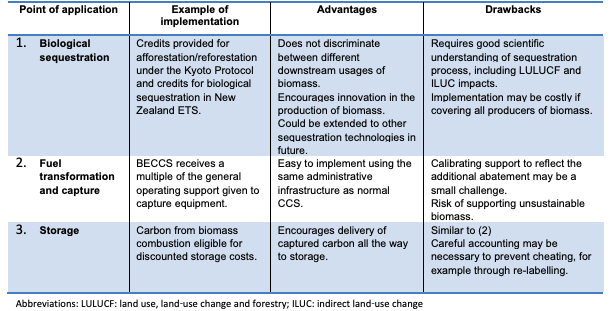Preventing Climate Change with BECCS: Bioenergy With Carbon Capture and Storage
Contributor: Jackie Vandermel
Introduction and History
BECCS, which stands for bioenergy with carbon capture and storage, is a geo-engineering(1) technique that, in addition to being an alternative for fossil fuel energy, removes carbon dioxide from the atmosphere. BECCS is being proposed as a solution to prevent carbon emissions from being overshoot, which would result in global temperatures exceeding the 2015 Paris agreement on climate change’s aim of less than 1.5 degrees Celsius.
BECCS process, Liam McGill
The concept of BECCS first appeared in the book Eco-Restructuring: Implications for Sustainable Development, which was published by The United Nations University Press in 1998. The author, Dr. Robert H. Williams, who was a Senior Research Scientist at the Princeton Environmental Institute at Princeton University, was calculating in the chapter "Fuel decarbonization for fuel cell applications and sequestration of the separated CO2" how biomass, combined with carbon capture and sequestration, could produce hydrogen energy. Because hydrogen energy is a zero-emission fuel, he proposed that biomass, combined with Carbon Capture and Sequestration (CCS), would also remove carbon dioxide from the atmosphere. Thus, the concept of BECCS, a negative emissions technology, was born.
The Process, Purpose, and Benefits
BECCS is a process that begins with growing biomass, which is organic matter. Commonly used biomass for this process is wood and compost. The biomass is then converted to bioenergy, which is renewable energy. The biomass is burned and converted to bioenergy— electricity, liquid or gas fuels, or heat. While burning biomass is considered to be carbon neutral(2), the carbon emitted in BECCS is captured and sequestered, or stored, underground in mountains, valleys, and other geological formations, for later usage. Thus, BECCS is considered to be carbon negative(3). The carbon dioxide can also be stored in products that last a long time, such as harvested wood or landfills.
A Research AgendaBiomass energy carbon dioxide removal and sequestration steps, Negative Emissions Technologies and Reliable Sequestration
The United Nations presses for the world to keep the global temperatures rise to 2 degrees Celsius—if possible, 1.5 degrees Celsius. Though the United Nations Climate Pledge Analysis predicts this to be impossible because warming in 2100 may reach 3.2 degrees Celsius, Carbon Brief states that Earth can subsequently get back down to a 2 degrees Celcius level after overshooting it if humans are able to remove enough carbon dioxide emissions from the atmosphere. A negative emissions technology, BECCS may be a feasible method to remove a large amount of carbon dioxide emissions from the atmosphere. According to Fern, which is represented by the European Union, European Climate Foundation, and the David and Lucille Packard Foundation, to keep the global temperatures rise below 1.5 degrees Celsius, concentration of greenhouse gases in the atmosphere would need to be kept below 430 parts of carbon dioxide per million. They are currently at 403 parts per million, but with efforts made, the United States National Academy of Sciences estimates that BECCS could sequester 3.4 to 5.2 billion metric tons per year by 2100.
Likewise, BECCS is a feasible solution because it is also inexpensive. Per ton of carbon dioxide captured via BECCS, the cost may be between $20 and $100.
Currently, BECCS is included in integrated assessment models’ pathways for mitigating climate impacts, so the Paris Agreement does consider it to be a key technology for helping reduce impacts of climate change.
Past Projects and Uses
Tate & Lyle and Archer Daniels Midland (ADM) in Decatur, Illinois, was the first BECCS facility. ADM was originally a corn facility that each day, grinded thousands of bushels of corn into ethanol fuel, syrups, and other products. Near them was an ethanol plant, which allowed them to produce much ethanol fuel. However, their ethanol plant was also producing 150,000 metric tons of carbon dioxide per year. From 2007 to 2016, ADM was experimenting to capture the emissions from its ethanol plant and sequester the carbon dioxide in a layer of sandstone lying beneath the Illinois corn belt. Specifically, emissions were released by fermenting the corn, and as the corn grew, it would absorb carbon dioxide; the process captured carbon dioxide from the atmosphere, and the carbon dioxide was then injected underground. Though the BECCS plant absorbed over two million tons of the facility's emissions, the Decatur facility was powered by fossil fuels, so there were positive and negative impacts for the environment.
The Illinois Basin Decatur Project, Rosamund Pearce
In 2018, there were more than four other ethanol plants in North America, such as the Century and Petra Nova plants in Texas; these plants captured carbon dioxide and used it for Enhanced Oil Recovery. Enhanced Oil Recovery involves injecting carbon into oil fields to increase the pressure of an oil reservoir and produce more oil. Though carbon dioxide was sequestered underground, the process was not carbon negative because the carbon dioxide had not come from the conversion of biomass, which is BECCS. Additionally, the facilities were powered by fossil fuels.
Can CO2-EOR really provide carbon-negative oil? Christophe McGlade
There were also plans for small facilities in Saudi Arabia, Brazil, the Netherlands, and Norway to be built or to use BECCS.
Challenges
The world is familiar with bioenergy and biofuels, as these two technologies are widely used such as in transportation, charging electronics, and cooking. However, the world is not as familiar with carbon capture and sequestration in regards to its effectiveness and reliability.
BECCS may not be as effective as other methods for combating the effects of climate change. The United Nations Framework Convention on Climate Change does not prioritize in mitigating the impacts of climate change. Its effectiveness is also questioned because of its cost. Under $100 per tonne can be scaled up to store large amounts of carbon, but it may not be enough for climate change’s impacts. The Paris climate agreement reveals that about 20 billion tons of carbon dioxide would need to be removed from the atmosphere every year by 2100 to meet a global temperature rise of less than 2 degrees Celsius, but BECCS may only have the potential to remove between three and five billion tons per year.
BECCS requires land and time. Though BECCS could remove a large amount of carbon dioxide from the atmosphere, it would require a large sacrifice of agricultural, forestry and municipal waste. Furthermore, a commitment to using BECCS would require up to 40% of global cropland. This means half the land of the United States would be needed simply for BECCS. This amount of land could lead to biodiversity loss and less food availability. Less food availability could lead to other negative impacts, such as the price of food increasing.
Storing carbon dioxide via BECCS is not confirmed to be reliable. The Natural Resources Defense Council believes investing in BECCS is risky. Carbon dioxide may not be properly stored underground and could dangerously intermix with vegetation, for example. There may also be technical challenges because this is a new technology.
The hope of negative emissions via BECCS could delay urgent climate action. It is unlikely BECCS can be scaled up significantly to meet the climate targets, but polluters who keep using fossil fuels can use the idea to rebut their actions, thus delaying for themselves to participate in effective climate action.
Future, New Projects, Policies
BECCS has been considered since 2001, and in 2012, the International Energy Agency released an information paper on a policy strategy for carbon capture and storage. However, politicians are still uncertain about BECCS. They continue to ask questions about how BECCS fits in with carbon budgets and environmental policies, how effective BECCS is, whether it can be delivered in time for climate targets and whether it will meet the targets, and if the amount of needed biomass can be produced sustainably. Though, they all agree that the lifecycle emissions of BECCS needs to be thoroughly understood and new studies must be reported.
Advantages and disadvantages of BECCS incentive options, International Energy Agency
Conclusion
While BECCS, bioenergy with carbon capture and storage, can alleviate some effects of climate change, its negative impacts should be recognized. Additionally, BECCS should not be the only solution used to combat climate change. Ultimately, BECCS, along with other approaches, will contribute to preventing the global temperatures from continuing its current rise.
*Footnotes
Geo-engineering is engineering or intervening in Earth’s natural systems to help mitigate the devastating impacts of climate change.
Carbon neutral refers to stored carbon being released, thus the same amount of carbon is in the atmosphere from before the carbon was stored.
When something is said to be carbon negative, that means the something removes carbon dioxide from the atmosphere rather than adds it. Its carbon footprint is less than neutral.






